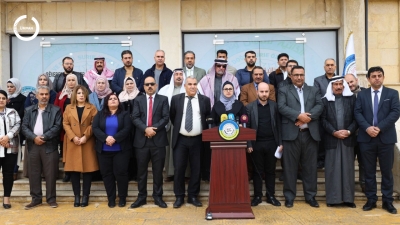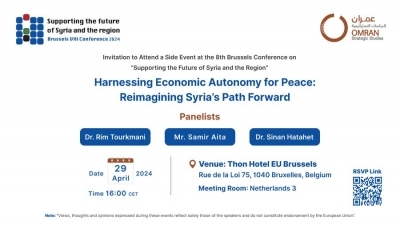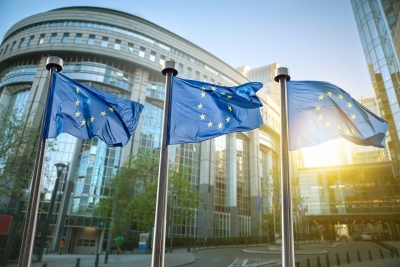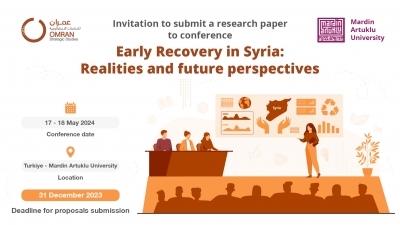Introduction
The Autonomous Administration of Northeastern Syria, established in 2013, governs a vast swath of Syrian territory, notable for its ethnic, religious, and social diversity. Adopting a federal structure, this administration significantly influences local governance dynamics. This summary reviews a research paper published in Arabic by the Omran Center, titled “الأداء السياسي للإدارة الذاتية منذ عام 2019: دراسة في آليات التحكم والاستحواذ”. The paper aims to explore the political strategies employed by the Autonomous Administration, particularly through its governing bodies: the Syrian Democratic Council and the Syrian Democratic Forces. It assesses the effectiveness of these strategies in light of shifting global interests in Syria, with a special focus on the northeastern region. The analysis, presented in this English summary, includes several critical evaluations:
- Examination of the Autonomous Administration's public communications and political actions to assess their alignment with its stated mission of managing diversity through a federal governance model. This includes scrutinizing official statements, event participations, and the consistency of these actions with the administration's goals of proposing an alternative governance model.
- Analysis of the legal frameworks that define political life under the Autonomous Administration, identifying the extent of influence exerted by the Democratic Union Party on these frameworks. The study explores the proposed social contract and the administration's party law to delineate the legal boundaries of political engagement.
- Evaluation of political freedoms within the Autonomous Administration's territory by examining the operational realities of political parties and movements within the aforementioned legal frameworks, highlighting the discrepancies between theoretical principles and practical application.,
- Investigation of the decision-making mechanisms within the Autonomous Administration, identifying key figures, influential factors, and the Democratic Union Party's strategies for maintaining control over political decisions.
- Articulation of the Autonomous Administration's political philosophy and vision, assessing its position on various issues including Kurdish dialogues, relations with the Syrian regime and international actors, and its standing in the local and international geopolitical landscape following the 2019 ceasefire announcement.
- Future projections for the Autonomous Administration in the context of the ongoing political deadlock and efforts toward territorial consolidation within Syria.
Key Factors in the Autonomous Administration's Political Performance Since 2019
By analyzing significant political statements, declarations, and both local and international meetings that occurred after the ceasefire announcement at the end of 2019 until the end of June 2023, over 120 outputs were observed, including official statements, press releases, and meetings.
These outputs can be analyzed based on three criteria: quantity, content, and targets. In terms of output type, a significant reliance on media statements was noted, indicating active engagement and communication with various media outlets, leveraging media interest during battles with ISIS. International meetings, indicating the vigor of their external relations office and interactions with Syrian components, followed.
Regarding content, the administration’s approach is evident through its intensified discussion on relations with Russia, especially after Russia became a new actor in Eastern Syria post the “Peace Spring” operation, notably in facilitating negotiations between the SDF and the Syrian regime. The results also highlighted a marked increase in statements about relations with the Assad regime, aiming for partnership in managing and protecting the region, alongside criticisms of the regime's strategy towards the Kurdish issue and attempts at normalization with Turkey. Numerous statements condemned Turkish attacks and called for international intervention to protect their controlled areas, showing a tendency towards rapprochement with Arab countries.
Concerning the targeted audience, the administration held over 30 meetings inside and outside Syria, with Syrian components and political parties, aiming for understanding agreements. This was attributed to ongoing challenges in entering the Syrian Negotiation Committee and participating in the Constitutional Committee, in addition to diverse international meetings with representatives from various European countries, the United States, and Russia.
Analysis of the official statements and press releases reveals the administration's political stance during the specified period on several issues: stance towards local actors, the regime and negotiations with it, Kurdish-Kurdish dialogue, the Syrian political process, and international actors, including Turkey, Russia, the United States, and Arab countries.
Engagement with Local Issues and Political Entities
The approach towards local matters and political factions is discernible through the Autonomous Administration's political ideology, its interactions with the Syrian regime, its relations with opposition groups, and its involvement in Kurdish-Kurdish dialogue.
- Political Ideology of the Autonomous Administration: The administration underlines its adherence to Abdullah Öcalan's “Democratic Nation” concept, which champions “decentralization, equality, and pluralism,” while expressly not pursuing the establishment of a Kurdish nation-state within Syria. This declared political ideology is said to mirror the regional populace's aspirations for Syria's future, encapsulated in initiatives like the one proposed for Syria's resolution last April. Such initiatives, with their leftist orientation, aim to resonate within Syria's culturally and politically diverse landscape. The SDF has consistently emphasized its commitment to respecting all societal segments, particularly engaging with Arab tribes through numerous dialogues, reinforcing its political alliances. However, the tribal uprising in Deir Ezzor in September 2023 underscored the disparity between theoretical commitments and practical application, with the SDF facing criticism for not meeting the tribal demands for better living conditions and more representative governance structures, as well as for its forceful suppression of tribal dissent.
- Kurdish-Kurdish Dialogue Dynamics: The representation of Syrian Kurds remains a contentious issue, marked by ongoing rivalry within the Kurdish political sphere. This rivalry is especially pronounced between the Democratic Society Movement (Tev-Dem) and the Kurdish National Council. Initial dialogues initiated in Erbil during 2012 and 2013 have seen limited progress, hindered by a lack of implementation of agreed outcomes. The Syrian Democratic Forces’ call for dialogue among Kurdish factions in November 2019, buoyed by American support, aimed at forging a complex consensus to enhance local empowerment, engage with the Syrian opposition more effectively, and mitigate Turkish tensions. However, dialogues have been stymied by disagreements over full administrative, financial, and military partnership and the persistent affiliation with the PKK, alongside demands for clear stances on inter-Kurdish military conflicts and coalition withdrawal requests.
- Interactions with the Syrian Regime: In February 2020, the Assad regime expressed willingness to engage in substantial negotiations with the SDF, prompted by Russian mediation. The SDF advocated for a revision of local governance laws to ensure their involvement in regional administration while the remaining part of the regime's military structure rejected the Sochi and Astana negotiation tracks. However, by December 2021, the head of the SDF Council announced the failure of these talks, highlighting Russia's inability to facilitate a successful dialogue with the regime.
- Relations with the Syrian Opposition: Having been excluded from official opposition frameworks, the Autonomous Administration sought alternative alliances with the Syrian opposition, embarking on earnest efforts marked by several meetings in Syria and abroad. Despite these endeavors, tangible outcomes were elusive, largely due to perceptions of the SDF's dominant stance and unwillingness to relinquish significant positions or authority. The administration's diplomatic efforts have struggled due to its team's rigid approach and failure to introduce potentially more acceptable and negotiable figures to the international community.
Engagement with International Entities
The Autonomous Administration's interactions with global entities, whether allies, adversaries, or neutral states, exhibit a nuanced spectrum of diplomatic strategies and positions.
- Interactions with Turkey: The SDF has repeatedly signaled its willingness to negotiate a mutual understanding with Turkey, sidestepping the contentious issue of its links with the PKK—a point of contention leading to Ankara's firm rejection. This stance places SDF and Autonomous Administration leaders in direct opposition with Turkey, where they are viewed through the prism of PKK affiliations, a group Turkey deems terrorist. In light of changing political climates within Turkey, the SDF showed keen interest in the 2023 elections, supporting the People's Party and Green Left Alliance with public demonstrations in Syria's east, anticipating the outcomes might favor their position. However, Turkish military strikes against SDF positions have been consistently condemned by the SDF, which calls for international intervention to halt Turkey's military actions in northern Syria. The aftermath of Turkey's “Peace Spring” operation notably constrained the SDF's maneuverability, highlighting the impact of Turkish-Russian and Turkish-American agreements on the SDF's operational capacity.
- Relations with Russia: The SDF's rapport with Moscow is multifaceted, viewing Russia as both a mediator with the Syrian regime and a counterbalance to Turkish threats. However, the expectation for Russia to leverage its influence over the Syrian regime for productive dialogue has not been met, with Russia and the regime potentially using Turkish aggression as leverage against the SDF. Tensions have also risen from Russia's non-compliance with maintaining observation points and pressuring Turkey to cease drone attacks. A significant point of contention remains Russia's push for the SDF to cede border control to the Syrian regime and withdraw southward, a proposition the SDF outright rejects despite recognizing Russia's role as a deterrent to Turkish advances.
- Engagement with Europe and the United States: Western delegations visiting eastern Syria focus primarily on counterterrorism efforts and the situation in Al-Hol camp, where the administration has capitalized on the international concern over ISIS detainees to bolster support. The administration also emphasizes the ongoing need for the international coalition's presence to maintain regional stability. It advocates for a reevaluation of Western relationships with Syrian opposition bodies and calls for increased Western pressure on Turkey to safeguard Autonomous Administration territories from potential military incursions. The Ukrainian conflict has notably influenced Western diplomacy, necessitating concessions to Turkey for broader strategic goals, such as NATO expansion.
In summary, the Autonomous Administration's international stance is characterized by efforts to maintain balanced ties with major powers like the U.S. and Russia, leveraging its anti-terrorism credentials while seeking broader engagement with regional actors. The administration's main challenge remains navigating Turkish opposition to its political legitimacy and regional influence.
Future Results and Trends: Identification with Syrian File Scenarios
Governance Legitimacy: The Autonomous Administration has undertaken legislative initiatives to build its governance credibility within its jurisdictions. Despite these efforts, the legislative frameworks have faced criticism over their development and enactment procedures, marked by structural weaknesses and lack of societal acceptance. This discord arises from a misalignment with local societal values. The implementation of these legislative measures has largely faltered, hindered by the Democratic Union Party (PYD) and its ideological counterpart, the Kurdistan Workers' Party (PKK), which exert centralized control over the administration’s political, service, and security mechanisms.
- Political Efficacy: The “Peace Spring” operation has notably shifted the ideological leanings within the PYD, leading to an increase in right-wing influence and the centralization of decision-making processes around a select few leaders. Despite the interference from the PKK in political and security areas, this military endeavor required the Syrian Democratic Forces (SDF) to make strategic concessions to forge new alliances.
- Engagement with Local Forces: Attempts by the SDF to engage in broader Syrian political frameworks, such as the Syrian Negotiation Committee and the Constitutional Committee, have been impeded by Turkish resistance. This resistance prompted a strategy of openness towards diverse Syrian political groups. However, the monopolistic control over decision-making by the PYD's leadership, without meaningful compromises or the establishment of authentic partnerships, has hampered effective communication and collaboration efforts, notably with entities like the Kurdish National Council.
- International Engagement: Following the “Peace Spring” military operation, the SDF subtly modified its approach to international relations, strengthening ties with Western allies while exploring alliances with Russia and the Syrian government. This shift resulted in certain concessions being made. Despite active efforts, a significant diplomatic breakthrough has yet to be achieved, affected by the changing dynamics of Russian-Turkish relations and the broader geopolitical consequences of the Ukraine conflict, prompting Western nations to approach Turkish concerns with increased caution.
Future Prospects and Political Efficacy
The future of the self-governing entity in northeast Syria is intricately linked to both internal policy decisions around governance and external geopolitical dynamics. Despite a foundation built on control, regulation, and centralization, vulnerabilities exist, particularly around issues of representation, political freedom, and the broader civil and political milieu.
- Regime Influence Expansion: The prospect of the Syrian regime reasserting control over the northeast is a complex scenario with both facilitating factors and significant barriers. Factors suggesting this could happen include the regime's gradual expansion of control, shifts in international politics favoring increased regional cooperation with the regime, and normalization efforts. However, challenges such as the American military presence, creating a security buffer, and the regime's resource limitations due to economic and security crises, serve as substantial roadblocks. Despite these challenges, there have been notable attempts at rapprochement between the self-administration and both the Syrian regime and Russia, aimed at securing recognition and negotiating for resources and administrative autonomy. Yet, major hurdles remain, notably the regime's reluctance to decentralize power significantly and Turkey's opposition to any empowerment of the self-administration.
- Maintaining the Status Quo: The persistence of a weakened central regime alongside strengthened local authorities suggests a continued trend towards de facto decentralization. The self-administration has undertaken reforms, such as amending its governing framework and proposing new structures to bolster its position in this scenario. However, opposition from Turkey, which rejects unilateral moves towards decentralization, along with skepticism from Russia and the Syrian regime, poses significant challenges. The strategy of sustaining the current state of affairs, bolstered by strategic leadership adjustments and the balancing of relations with both Russian and American forces, appears to be a pragmatic short-term approach, likely to prevail in the near term.
- Engagement in a Broader Syrian Political Process: The potential activation of a comprehensive political process for Syria, particularly in light of stalled UN Resolution 2254 implementations, opens up discussions for decentralization as a viable path forward. The self-administration, through the Syrian Democratic Forces (SDF), has prepared for such an outcome, leveraging Western support and acknowledging the deadlock and risks associated with the resurgence of extremism and increased Iranian influence. To be considered a genuine stakeholder in this process, the SDF must demonstrate negotiation flexibility, confront threats from Iranian militias effectively, adopt a less adversarial stance towards Turkey and Syrian opposition groups, and progress in Kurdish-Kurdish dialogue. However, entrenched positions within the leadership, particularly ties to the PKK and adherence to its political agenda, make this scenario challenging, hindering the self-administration's ability to pivot towards a more inclusive and flexible political strategy.
Concluding Insights
The English summary of the full Arabic paper aim to highlights the Autonomous Administration's efforts to maneuver through a multifaceted landscape of both local and international hurdles. In its quest to establish and maintain a viable governance framework, it faces the daunting task of navigating geopolitical tensions and internal challenges. By capitalizing on the shifting allegiances and regional power plays, the administration's continuity and effectiveness hinge on its capacity to evolve within this dynamic political climate. The uncertain future of this governance model is intricately linked to potential political resolutions and its adaptability to the ever-changing global stage.
________________________________________
For further insights into the governance and political dynamics within Syria's self-administration regions since 2019, the full study (Arabic Version) is accessible through the Omran Center: Click here for the study.




